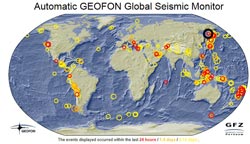Strong earthquake at exceptional depth

Most recent large event: Sea of Okhotsk<br>Magnitude: 8.2<br>Origin time: 2013-05-24 05:44:49 UTC<br>Epicenter: 153.24°E 54.89°N<br>Depth: 605 km<br>
Because of the great depth of the earthquake a tsunami is not expected and there should also be no major damage due to shaking.
Professor Frederik Tilmann of the GFZ German Research Centre for Geosciences: “The epicenter is exceptionally deep, far below the earth's crust in the mantle. Such strong earthquakes at this depth generally occur only in a few places in the world: namely where geologically old oceanic plates with more than 80 million years of age push quickly under another plate.”
Because of their age, these plates are comparatively cold and remain cool even at great depths if they also descend quickly. The temperature of the plates stays below 650 to 700 °C, the highest temperature at which rocks can break rapidly in an earthquake rather than deforming. In the case of the Okhotsk-earthquake, the Pacific plate moves at a speed of about eight centimeters per year underneath the Okhotsk microplate.
The quake also follows a highly unusual accumulation of eleven shallow earthquakes with magnitudes from 5.5 to 6.1 within two days. This swarm is, however, located over 650 kilometers in a direct line away from today’s earthquake, so a direct relationship cannot be confirmed.
see also for pictures:
http://geofon.gfz-potsdam.de/eqinfo/seismon/globmon.php
http://www.gfz-potsdam.de/portal/gfz/Public+Relations/M40-Bildarchiv/Okhotsk-Beben/130524_Okhotsk
Media Contact
More Information:
http://www.gfz-potsdam.deAll latest news from the category: Earth Sciences
Earth Sciences (also referred to as Geosciences), which deals with basic issues surrounding our planet, plays a vital role in the area of energy and raw materials supply.
Earth Sciences comprises subjects such as geology, geography, geological informatics, paleontology, mineralogy, petrography, crystallography, geophysics, geodesy, glaciology, cartography, photogrammetry, meteorology and seismology, early-warning systems, earthquake research and polar research.
Newest articles

Properties of new materials for microchips
… can now be measured well. Reseachers of Delft University of Technology demonstrated measuring performance properties of ultrathin silicon membranes. Making ever smaller and more powerful chips requires new ultrathin…

Floating solar’s potential
… to support sustainable development by addressing climate, water, and energy goals holistically. A new study published this week in Nature Energy raises the potential for floating solar photovoltaics (FPV)…

Skyrmions move at record speeds
… a step towards the computing of the future. An international research team led by scientists from the CNRS1 has discovered that the magnetic nanobubbles2 known as skyrmions can be…




















